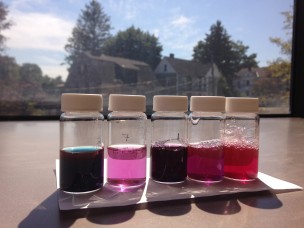Nanoparticles are more than just tiny particles. In our first Lab Report of the school year, new columnists Katie Kaus and Mitchell Ramsey dish on the lab of Michelle Personick, Assistant Professor of Chemistry.
When you think of nanoparticles, what do you think of? Really tiny particles? Or maybe sunscreen?
Not Michelle Personick, the University’s newest Professor of Chemistry. She thinks of a variety of bright colors, interesting 3D shapes, and ways to design energy efficient industrial processes.
The Personick lab works with noble metal and noble metal alloy nanoparticles—that is, nanoparticles made up of gold, platinum, palladium and silver, sometimes mixed with copper. The word “nanoparticle” is simply indicative ofscaleand refers to any structure that falls between one and one hundred nanometers, or between one billionth and one hundred billionths of a meter. So nanoparticles and nanomaterials are made up of atoms just like bulk materials—such as jewelry or gold bar—but behave differently.
“[A metal nanoparticle] is basically a very small piece of metal, but it’s big from a chemist’s perspective, because it’s a lot of atoms,” Personick said. “So we can control its shape, and that’s what we do here. We try to control the shape of these very small pieces of metal.”
Research in the Personick lab has two main focuses. The first focus is discovering ways to create different shapes of nanoparticles. Early in the development of nanoparticles, only spherical ones could be made. But as the field grows, scientists figured out ways to create nanoparticles with triangular-prism, cubic, or other geometries. A really neat property of different-shaped nanoparticles is that they appear as different colors to the human eye. In an example that Personick described, spherical silver nanoparticles in solution can appear yellow in color, but when shifted into a triangular-prism shape by exposure to light, they become turquoise.
The importance of different shaped nanoparticles leads into the second focus of research in the Personick lab, which is something called catalysis. Catalysis, as any Introductory Chemistry student can tell you, refers to making a reaction proceed more quickly and efficiently.
“[Catalysis using nanoparticles] isimportant because the chemical industry is the second largest consumer of delivered energy,” Personick said. “In the chemical industry, we use petroleum fuels or other kinds of fuels not only as starting materials to make useful chemicals—for making, say, plastics—but also to heat up our reactors to 600 or 800 degrees, because that’s the temperature we need to make the [synthesis] process go. So we’re trying to be more energy efficient and not waste energy. We’d rather just use it as a starting material and not have to heat up our reactors, so the metal nano particle surface provides a place for the reaction to happen at a lower temperature.”
The shape of metal nanoparticles affects the efficiency of their catalytic properties. Catalyst materials work by providing a surface for starting materials to stick to, which helps them interact with one another. These reactions occur only on the surface of a catalytic material, so any internal volume is a wasted. Many industrial chemical processes already rely on materials such as platinum or palladium as catalysts. Using metal nanoparticles increases the total surface area, and optimizes the usefulness of expensive catalysts like platinum, gold, or silver. The usage of these metal catalysts in the nanoparticle form means that a smaller amount of the materials is used. And incorporating cheaper metals like copper to create alloys greatly reduces the cost of industrial chemistry.
The industrial capabilities of nanoparticles are all well and good, but what about nanoparticles that make it into cosmetics, sunscreen, and things we come into contact with every day? Are these things harmful to living organisms?
“We’ve had titania nanoparticles in sunscreens for a long time—and that’s actually what we call poly disperse, so bigger particles and smaller particles,” Personick said. “We haven’t really seen too much of an issue with that, but it’s one of those things where we’re generating a lot of materials, and you do need to test every material that you work with. Carbon nanotubes have similarities to asbestos, which is absolutely dangerous, it gets in your lungs and does bad things. [For] gold nanoparticles, it depends what you put on the surface. There are some things that you can put on the surface of gold nanoparticles that are nontoxic—they’ve been put in mice and animals and there’s no problem; there’ve been clinical trials for humans, too. But if you put a different molecule on the surface and that molecule is toxic, there could be problems.”
So there you have it. Nanoparticles may be small, but the things we are learning from them have monumental implications.

Comments are closed